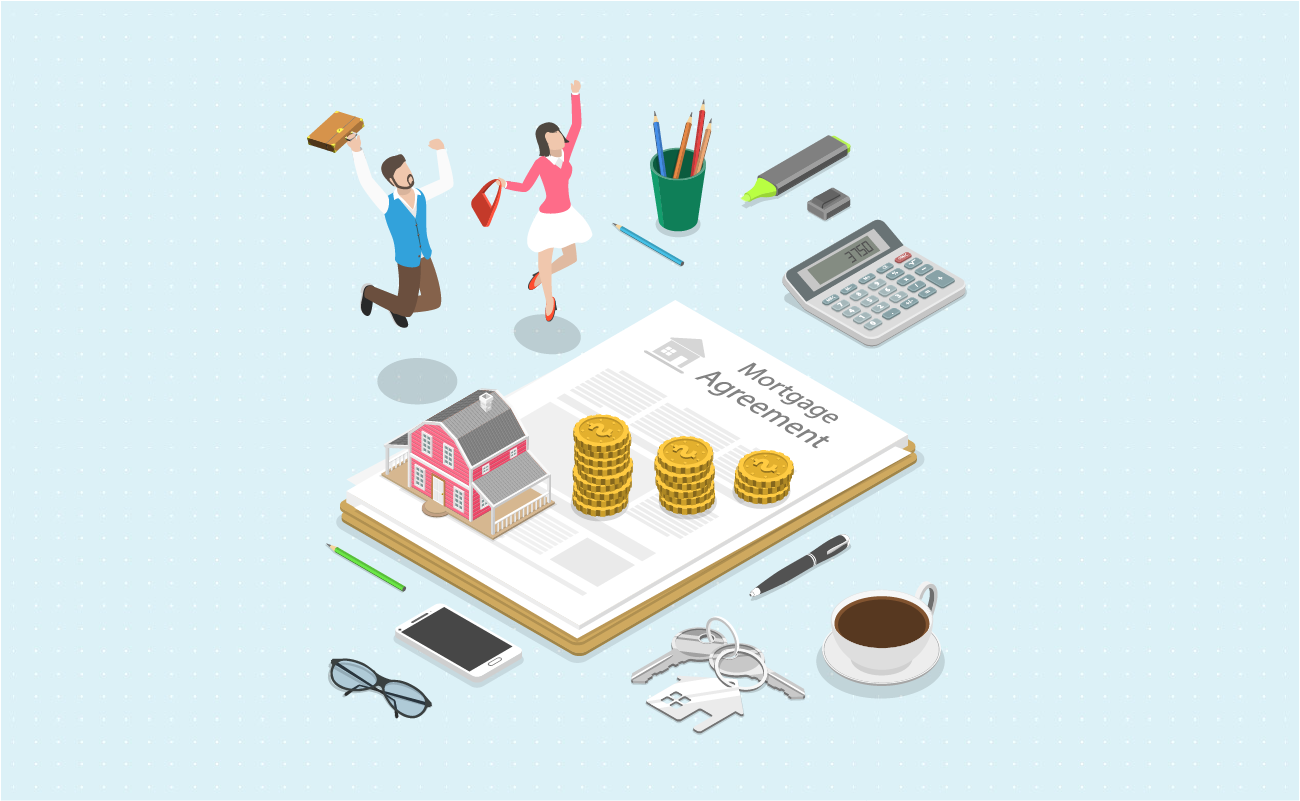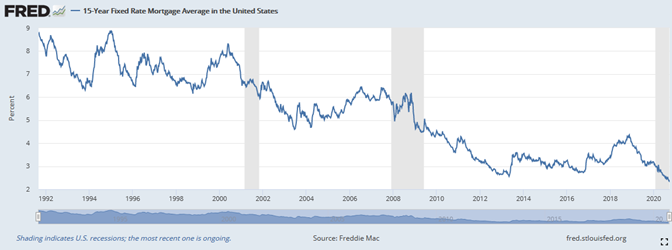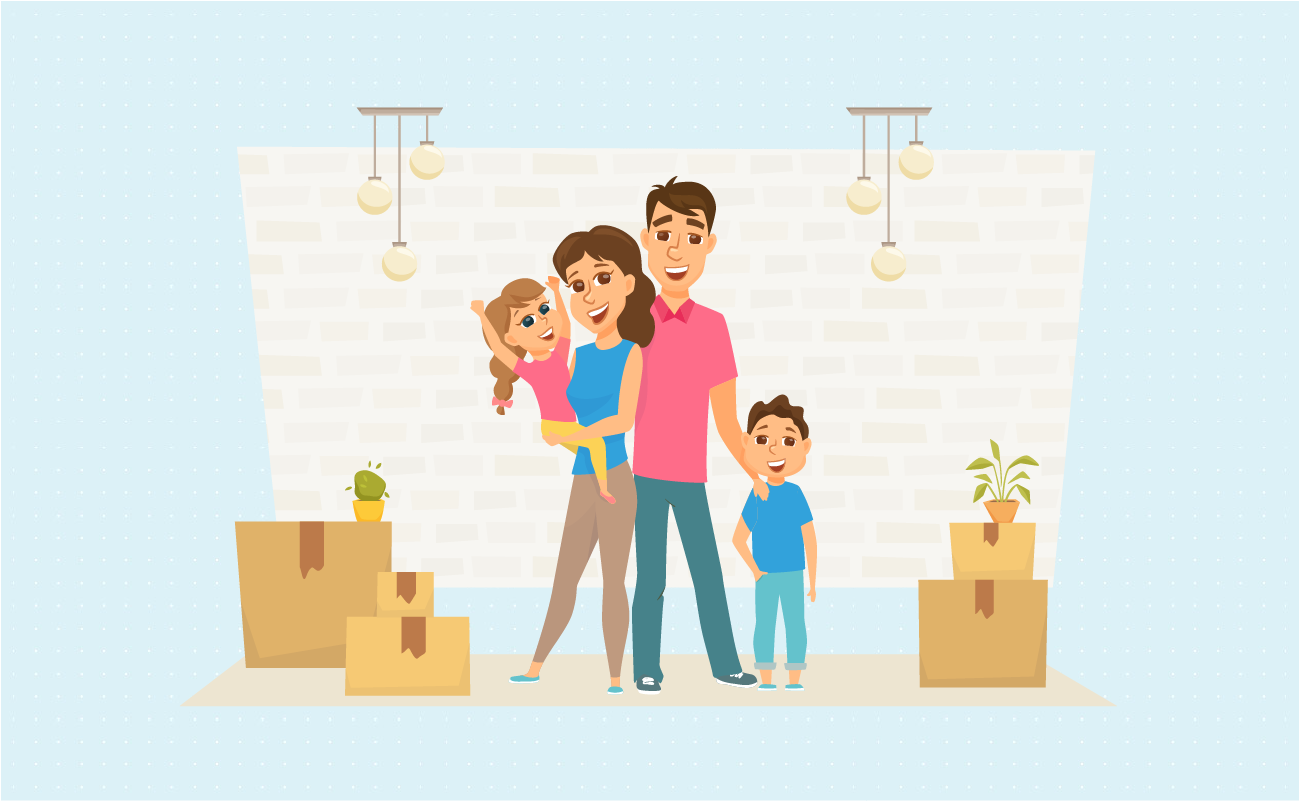Fixed Rates
30 yr
25 yr
20 yr
15 yr
10 yr
Compare Terms
Compare Rates
Real APR
Adjustable Rates
Qualification
Affordability
Renter Affordability
Rent vs Buy
Price per Square Foot
Jumbo
Home Sellers
 15 Year Fixed Mortgage Payment Calculator
15 Year Fixed Mortgage Payment CalculatorThis calculator helps home buyers estimate their monthly principal & interest payment along with the full PITI mortgage payment when buying a home using a 15-year fixed rate mortgage loan. The 15-year is a popular choice among homeowners who want to refinance their homes into a lower rate without resetting the amortization schedule back to 30 years. Enter the home price, down payment, APR, loan term & other homeownership expenses and we will estimate the cost of homeownership. Once you have entered all of your details you can use the button at the bottom of the calculator to create a printable amortization schedule.
Guide published by Jose Abuyuan on September 26, 2020

Looking for financing options is a handful. When it comes to homebuying, you need a good credit score to secure a favorable rate. And to find the best deal, you must shop for different lenders to compare offers. It’s also important to choose the right payment term that fits your budget.
While you’re exploring mortgage options, a 15-year fixed-rate loan might catch your attention. And though 30-year fixed mortgages are more popular for homebuyers, others prefer to take shorter payment terms. This option can actually help you save more money in the long-run.
Our guide below will discuss how 15-year fixed mortgages work and when it’s worth choosing one. We’ll talk about the type of mortgages that offer this financing option, as well as its benefits and disadvantages. We’ll also discuss how it compares to 30-year fixed-rate loans, and why it’s a common refinancing tool used by many consumers.
Fifteen-year fixed-rate loans come with a locked interest rate for the entire term. Because of the fixed rate, your monthly principal and interest payments remain the same for 15 years. It assures your mortgage payments stay within an affordable range throughout the entire loan. Compared to 30-year fixed mortgages, the shorter term allows you to pay off your loan in half the time.
Moreover, 15-year fixed mortgages have lower interest rates than longer terms. This is usually lower by 0.25 percent to 1 percent than 30-year fixed loans. The shorter term and lower interest rates help borrowers save tens of thousands of dollars on overall interest charges. However, as a trade-off, expect to have higher monthly payments when you choose a 15-year fixed mortgage.
When it comes to the payment schedule, 15-year-fixed loans follow a traditional amortization schedule. It calculates the number of monthly payments you need to make to pay off your loan within 15-years. An amortization schedule also shows how much of your payments go toward your loan’s principal and interest.
With a traditional amortization schedule, more of your payments go towards the interest during the first years of your loan. This means your principal balance is reduced at a much slower pace. But towards the latter half of the term, more of your payments are applied to your principal. As the principal is reduced, so does your interest payments. As long as you make payments on time, your mortgage should be paid within 15 years.
To generate a sample amortization schedule for a 15-year fixed-rate mortgage, use our calculator above.
Mortgage payments don’t end with principal and interest payments. It comes with other housing costs such as property taxes and homeowner’s insurance. These expenses can change throughout the term, so it’s best to have a little room in your budget in case they increase.
Depending on the type of loan you get, you might need to pay additional mortgage insurance. If you obtain a conventional loan, you might be required to pay private mortgage insurance (PMI). Meanwhile, if you obtain a government-backed mortgage such as an FHA loan, you’re charged a mortgage insurance premium (MIP).
To estimate your total monthly mortgage payment, make sure to add your principal and interest payment, regular taxes, and insurance costs.
For example, suppose you took a 15-year fixed mortgage at 3 percent APR. The house is priced at $250,000. Using the calculator above, let’s estimate your total monthly mortgage payment.
| Loan details | Amount |
|---|---|
| Monthly interest & principal payment | $1,381.16 |
| Monthly taxes, insurance, & HOA | $300 |
| Total monthly mortgage payment | $1,681.16 |
If you take a conventional loan and make a 20 percent down ($50,000), your monthly principal and interest payment will be $1,381.16. With monthly taxes, property insurance, and homeowner’s association fees at $300, your total monthly mortgage payment will be $1,681.16.
Of course, your taxes and insurance costs may increase anytime in the future. Before this happens, make sure to set aside extra money to cover your monthly mortgage payments.

Fifteen-year fixed mortgages are available under the following conventional mortgages and government-funded housing loans:
Conventional mortgages are financing options that are not directly funded by the government. These are often bundled into mortgage-backed securities that are insured by government-sponsored entities (GSEs), Fannie Mae and Freddie Mac.
Conventional loans are offered by private banks, credit unions, and mortgage companies. To be eligible, borrowers must have a credit score of at least 680. If you have a higher credit score of 700 and above, you are qualified for lower rates. This type of financing is usually taken by high-income borrowers with good credit histories and stable sources of funds.
Furthermore, conventional loans are classified into two main types:
With government-backed mortgages, borrowers have access to low down payments and more lenient qualifying standards. And because they are directly funded by the government, these loans often have lower rates than conventional loans. Government-sponsored mortgages are geared towards low to moderate-income borrowers with poor credit scores.
For example, with an FHA loan, you can qualify for a mortgage with a credit score of 500. Moreover, if your credit score is 580, you can make a down payment as low as 3.5 percent. As for VA loans and USDA loans, qualified borrowers can take advantage of a zero down payment.
Homebuyers can obtain the following government-sponsored mortgages:
Homebuyers consider 15-year fixed-rate loans for two main reasons:
People take 15-year fixed loans to pay off their mortgage in a shorter period of time. Instead of 30 years, why not pay your home loan in half the time? You’ll also save tens of thousands of dollars on interest expenses compared to a 30-year term. This option is a good fit for borrowers with high credit scores and a consistent stream of funds. You can obtain a favorable deal with 15-year fixed-rate loan if you have an excellent credit rating.
Paying your home loan before retirement is beneficial. You no longer have to worry about mortgage payments once you stop working. Once you pay off your loan, it helps free up your cash flow. This means more of your money can go towards savings such as retirement funds and other important life investments. Instead of paying your mortgage, you can also use the money to pay for your child’s college tuition.
Though it’s used as loan purchasing tool, more consumers use 15-year fixed mortgages as a refinancing instrument. Refinancing is the process of replacing your existing mortgage with a new loan. This allows you to obtain a lower rate and shorten your payment term. If you have a 30-year fixed mortgage and can afford to refinance into a shorter term, consider a 15-year fixed-rate loan. Taking this option can help you save a substantial amount on interest costs.
Just how much can you save if you take a 15-year fixed mortgage? Using the calculator on top, let’s compare monthly payments and total interest costs between a 15-year fixed mortgage and a 30-year fixed term.
Let’s say your home is priced at $375,000 and you made a 20 percent down payment of $75,000. This removes the PMI on your conventional loan. The following table shows your monthly principal and interest payment and total interest charges for a 30-year fixed mortgage and a 15-year fixed loan.
| Loan details | 30-Year Fixed Mortgage | 15-Year Fixed Mortgage | Difference |
|---|---|---|---|
| Interest rate (APR) | 3.25% | 2.73% | 0.52% |
| Monthly principal & interest payment | $1,305.62 | $2,033.01 | $727.39 |
| Total Interest | $170,022.82 | $65,941.99 | $104,080.83 |
In this example, the 15-year fixed loan has a rate that is 0.52 percent lower than the 30-year option. When it comes to monthly principal and interest payments, the 30-year fixed mortgage is $727.39 more affordable than the 15-year fixed loan.
However, the most substantial savings is seen when we compare the total interest costs. With a 30-year fixed mortgage, you’ll pay a $170,022.82 in overall interest charges. Meanwhile, you’ll only pay $65,941.99 on total interest costs with a 15-year fixed-rate loan. It slashes more than half off your interest charges. In this example, if you choose a 15-year fixed mortgage, you save a total of $104,080.83 on interest costs.
On the other hand, many homebuyers cannot afford expensive monthly payments. This is especially the case for first-time buyers who are still building their income. As a result, many of them choose 30-year fixed rate loans. The extended term allows people to borrow a larger loan amount, giving them the option to purchase a larger house or a property in a better location.

Before making extra payments, make sure to ask your lender about prepayment penalty. Paying this expensive fee can cancel interest savings from extra payments. Prepayment penalty is usually applied within the first 3 years of your mortgage. Once the penalty period lapses, you can safely make extra payments. Some lenders may allow you to pay up to 20% of your principal during the penalty period before the fee is triggered.

Going for a 15-year fixed mortgage has many advantages. It mainly saves you thousands of dollars on interest charges compared to a 30-year fixed term. It also has a lower interest rate that’s typically 0.25 to 1 percent lower than a 30-year fixed loan. The shorter term helps you gain home ownership faster. By then, you’ll free up cash flow for other important expenses, such as your child’s college tuition. And when you’re equity-rich, you can take out a home equity loan in case you need extra funds in the future.
Furthermore, if you choose a government-backed loan, a 15-year fixed term comes with loan-level price adjustments and more affordable fees. Your mortgage insurance is also lower if you take a 15-year fixed FHA loan.
On the downside, 15-year fixed mortgages have more expensive monthly payments than longer terms. The higher monthly payments can prevent you from borrowing a larger loan amount. As a result, it may keep you from buying a bigger home or choosing a property in a better neighborhood.
Moreover, consider the opportunity cost of making higher payments. It will limit your purchasing power and keep you from saving more money for retirement. You’ll also have less money to cover emergencies like accidents or sudden unemployment. Prioritizing mortgage payments can also keep you from investing in other worthwhile business ventures.
To summarize the pros and cons of a 15-year fixed mortgage, we created the table below:
| Pros | Cons |
|---|---|
| Locked interest rate – monthly principal & interest payment remains the same | Higher monthly payments compared to a 30-year fixed mortgage |
| Lower interest rate – usually 0.25% to 1% lower than 30-year fixed mortgages | Higher payments mean you can only qualify for a lower loan amount, while 30-year fixed mortgages can offer a larger loan amount |
| Saves you more on total interest charges compared to 30-year fixed mortgages | Keeps you from making other important purchases |
| Pay off your mortgage sooner, build home equity faster | Limits your retirement savings |
| Pay lower fees & obtain loan-level price adjustments if you get a government-backed loan (FHA, VA, & USDA loans) | Less emergency money in case of hospitalization or job loss |
| If your loan is from the FHA, you’re charged a lower MIP compared to a 30-year term | May keep you from investing in lucrative business ventures |
By now you know that 30-year fixed-rate mortgages are the most popular financing option taken by homebuyers. Research by the Urban Institute showed that 30-year fixed mortgages comprised 74. 4 percent of new U.S. mortgages in June 2020. This is based on Housing Finance at a Glance: A Monthly Chartbook, August 2020.
Fifteen-year fixed-rate loans are the second most popular mortgage product in the country. It comprised 16.4 percent of new loans in the U.S. market. Majority of these loans were refinances, as refinancing continues to surge because of the low interest rates. Refinancing rates have generally grown for Fannie Mae and Freddie Mac, reaching between 71 to 75 percent. Whereas Ginnie Mae’s refinancing rate increased to 49.2 percent.
On third place are adjustable-rate mortgages (ARM) which took 1.8 percent of the market share. These are loans which start off with a low rate, then change once the introductory period is through. For instance, if you have a 3/1 ARM, your rate is the same for 3 years. For the succeeding years, it can either increase or decrease, depending on market conditions. Since there’s risk of increasing monthly payments, many consumers with ARMs eventually refinance into a fixed-rate loan.
Lastly, 7.4 percent of the housing market share accounted for other mortgage products. This includes less popular loan options such as 25-year fixed mortgages, 20-year fixed-rate loans, and 10-year fixed-rate loans.

Graph from the Federal Reserve Bank
Mortgage rates have been historically declining in the past three decades. While 30-year fixed-rate loans have higher rates, 15-year fixed-rate mortgages have lower rates. The graph above shows the downward trend for 15-year fixed mortgage rates from 1992 to 2020.
In January 1992, 15-year fixed mortgage rates were around 7.79 percent. Between January 1992 to January 2002, rates did not go lower than the 6 percent range. By January 2003, it decreased to around 5.24 percent, remaining within the 5 percent range until 2008.
Toward January 2009, the average 15-year fixed mortgage rate declined to 4.62 percent. This dramatic decrease was largely due to the impact of the Subprime Mortgage Crisis, which occurred from 2007 to 2010. Between January 2009 to January 2012, rates kept between the 4 percent and 3 percent range.
In January 2013, the average rate fell at 2.64 percent, while it increased to 3.55 percent in January 2014. Rates kept within the 3 percent range between January 2015 to January 2020. In 2019, rates fell as low as 3.18 percent, with reports showing more consumers refinancing loans.
By January 2020, 15-year fixed rates dropped to 3.16 percent. The year ushered the coming of the COVID-19 crisis, pushing national unemployment rates up to 11.2 percent by the end of June 2020 (U.S. Bureau of Labor Statistics). By September 2020, 15-year fixed rates fell as low as 2.40 percent. During this time, the Federal Reserve continues to encourage consumers to keep buying homes and refinancing their mortgage to help keep rates from dropping lower.
| Date | Average 15-Year Fixed Rates | Origination Fees & Discount Points |
|---|---|---|
| January 3, 1992 | 7.79% | 1.7 |
| January 8, 1993 | 7.60% | 1.6 |
| January 7, 1994 | 6.74% | 1.6 |
| January 6, 1995 | 8.87% | 1.8 |
| January 5, 1996 | 6.56% | 1.7 |
| January 3, 1997 | 7.18% | 1.7 |
| January 2, 1998 | 6.61% | 1.8 |
| January 8, 1999 | 6.43% | 1.0 |
| January 7, 2000 | 7.73% | 1.0 |
| January 5, 2001 | 6.74% | 1.0 |
| January 4, 2002 | 6.62% | 0.8 |
| January 3, 2003 | 5.24% | 0.6 |
| January 8, 2004 | 5.17% | 0.7 |
| January 6, 2005 | 5.21% | 0.6 |
| January 5, 2006 | 5.76% | 0.5 |
| January 4, 2007 | 5.94% | 0.4 |
| January 3, 2008 | 5.68% | 0.6 |
| January 8, 2009 | 4.62% | 0.7 |
| January 7, 2010 | 4.50% | 0.7 |
| January 6, 2011 | 4.13% | 0.8 |
| January 5, 2012 | 3.23% | 0.8 |
| January 3, 2013 | 2.64% | 0.6 |
| January 2, 2014 | 3.55% | 0.7 |
| January 8, 2015 | 3.05% | 0.5 |
| January 7, 2016 | 3.26% | 0.5 |
| January 5, 2017 | 3.44% | 0.5 |
| January 4, 2018 | 3.38% | 0.5 |
| January 3, 2019 | 3.99% | 0.4 |
| January 2, 2020 | 3.16% | 0.7 |
| September 24, 2020 | 2.40% | 0.8 |

Take advantage of a 15-year fixed mortgage if you can afford higher monthly payments. This gives you substantial interest savings while helping you gain home ownership faster. Compared to a 30-year mortgage, it cuts interest charges in half. That’s money that can go toward building your savings, such as your retirement fund and paying for your child’s college education.
On the other hand, if your budget is too tight for a 15-year fixed mortgage, don’t fret. After a few years, if you’ve increased your income and improved your credit score, you can still refinance into a 15-year fixed-rate loan. Use this strategy to shorten your payment term while slashing years’ worth of interest charges. Just make sure to refinance early into the term and when rates are low enough to offset the expensive cost.
To understand how refinancing works, read our guide on our mortgage refinance calculator.
Jose Abuyuan is a web content writer, fictionist, and digital artist hailing from Las Piñas City. He is a graduate of Communication and Media Studies at San Beda College Alabang, who took his internship in the weekly news magazine the Philippines Graphic. He has authored works professionally for over a decade.